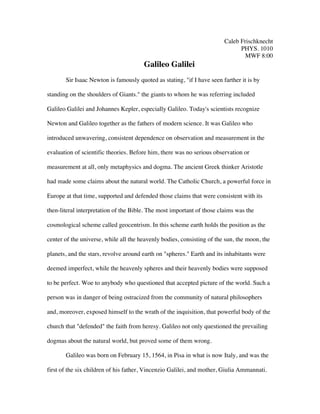
Galileo1
- 1. Caleb Frischknecht PHYS. 1010 MWF 8:00 Galileo Galilei Sir Isaac Newton is famously quoted as stating, "if I have seen farther it is by standing on the shoulders of Giants." the giants to whom he was referring included Galileo Galilei and Johannes Kepler, especially Galileo. Today's scientists recognize Newton and Galileo together as the fathers of modern science. It was Galileo who introduced unwavering, consistent dependence on observation and measurement in the evaluation of scientific theories. Before him, there was no serious observation or measurement at all, only metaphysics and dogma. The ancient Greek thinker Aristotle had made some claims about the natural world. The Catholic Church, a powerful force in Europe at that time, supported and defended those claims that were consistent with its then-literal interpretation of the Bible. The most important of those claims was the cosmological scheme called geocentrism. In this scheme earth holds the position as the center of the universe, while all the heavenly bodies, consisting of the sun, the moon, the planets, and the stars, revolve around earth on "spheres." Earth and its inhabitants were deemed imperfect, while the heavenly spheres and their heavenly bodies were supposed to be perfect. Woe to anybody who questioned that accepted picture of the world. Such a person was in danger of being ostracized from the community of natural philosophers and, moreover, exposed himself to the wrath of the inquisition, that powerful body of the church that "defended" the faith from heresy. Galileo not only questioned the prevailing dogmas about the natural world, but proved some of them wrong. Galileo was born on February 15, 1564, in Pisa in what is now Italy, and was the first of the six children of his father, Vincenzio Galilei, and mother, Giulia Ammannati.
- 2. Galileo's father was a musician and music theorist, who studied such matters as the relation of the pitch of a plucked string to the force stretching the string, the string's tension. This interest exposed Galileo at an early age to the investigation of phenomena through measurement. As a young man, Galileo considered becoming a priest, but at his father's urging, instead started studying medicine at the university of Pisa. In the middle of his course of study, he switched direction and studied mathematics instead, obtaining his degree in that field. In 1589, at the age of 25, Galileo was hired to teach mathematics at the university of Pisa, and three years later he took a position at the university of Padua, where he taught astronomy and mechanics, in addition to mathematics, for 18 years, until 1610. Although never married, Galileo had three children with Marina Gamba, who were born during 1600-06. The two oldest were girls, Virginia and Livia, born in 1600 and 1601, respectively. They were both sent to a convent, where they took the names Maria Celeste and Suor Arcangela and remained for their whole lives. The son, Vincenzio, was born in 1606. While at the university of Padua, Galileo made important discoveries in pure and applied science, including the study of motion, astronomy, and telescope construction. He taught for 18 years and during that time, became convinced that there was truth in the theory of Nicolaus Copernicus, a Polish astronomer, who believed that all planets including earth revolved around the sun. While still at Padua, in 1609, he built the first astronomical telescope. When he used it to look at the sky, he found that most of Aristotle's and Ptolemy's theories were wrong. His most important discovery was when he discovered the four moons of Jupiter in 1610, which were called the Galilean satellites in respects to him. Later that year Cosimo de Medici, Grand Duke of Tuscany, named
- 3. Galileo his personal mathematician. This brought him back to Florence once again where he continued his studies in astronomy. In 1613, he wrote a letter attempting to explain how the Copernican theory was agreed with both Catholic doctrine and correct Biblical explanation. A few of his enemies got a hold of the letter, and sent it to the inquisitors in Rome. The duty of the inquisitors was to find and discipline people who were against the teachings of the church. Galileo was then brought to Rome to be tried for his “crimes.” Fortunately for him, his charges were cleared and he was let go under one condition, which was that he was not to hold or defend the Copernican theory meaning that he wasn’t allowed to say it was true. Nineteen years later, in 1632, he published his first book, Dialogue Concerning the Two Chief World Systems. In this composition, he compared Aristotle’s and Ptolemy’s theories to that of Copernicus. He did this to show that the Copernican theory was more logical than the other two. Again the inquisitors tried him and this time he was found guilty. He was sentenced to life in prison, however, due to his old age and poor health, he was allowed house arrest in his home just outside of Florence. Eventually Galileo went completely blind and still managed to write his second book. He died on January 8, 1642, at the age of 78. His discoveries and theories have helped aid in many more scientific breakthroughs throughout the years.